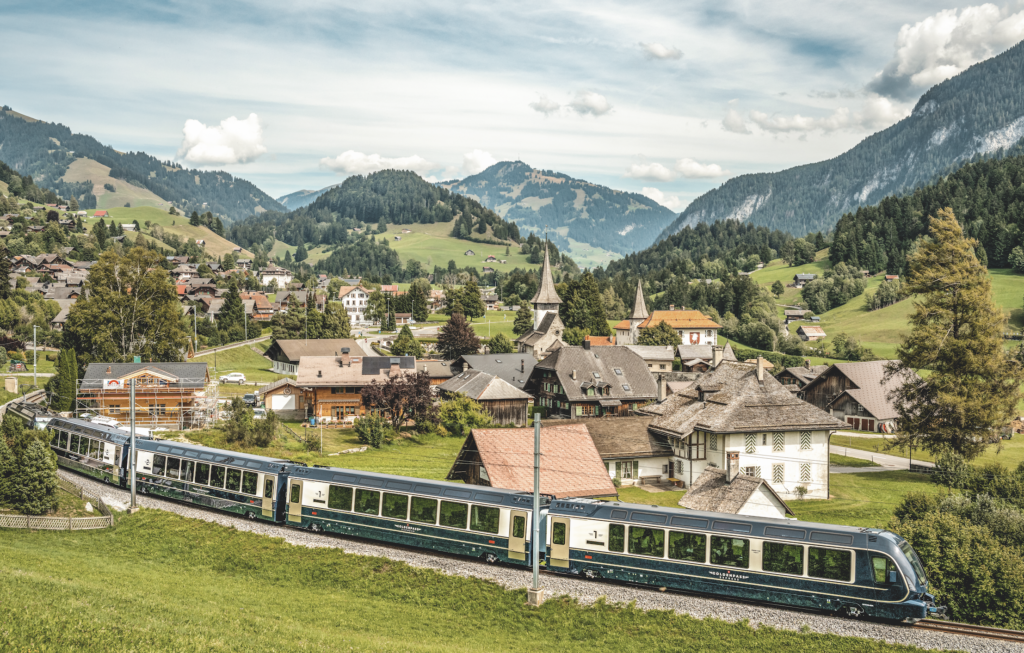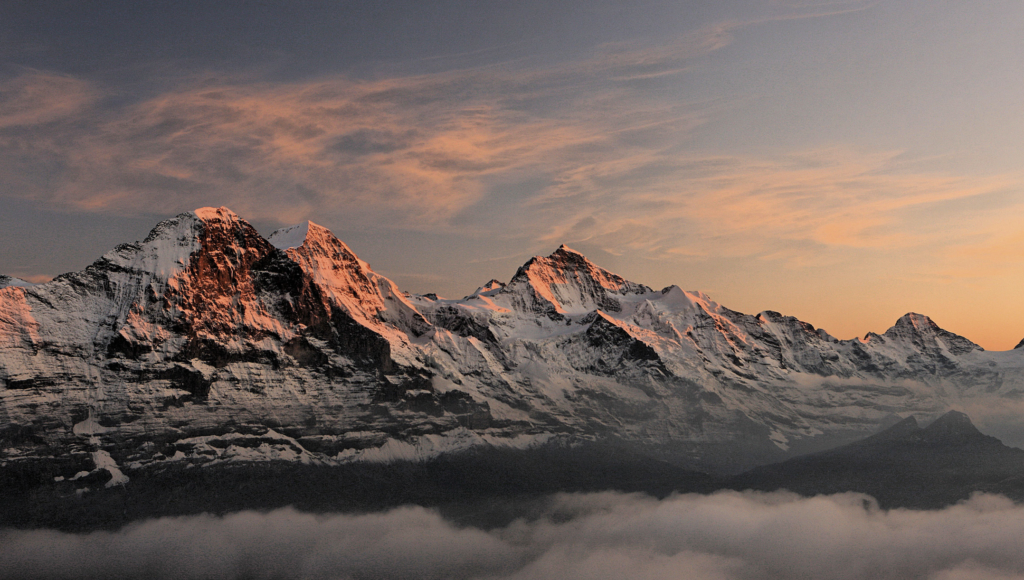IMAGINE the scene: you’re sipping fine white wine and eating delicate cheeses and charcuterie from a black slate board.
You relax in a plush leather recliner and gaze through huge windows at a kaleidoscope of velvety green meadows, and a backdrop of knife-sharp snowy mountains.
That’s the heavenly reality of a trip in the Prestige class section of Switzerland’s Golden Pass Express, a relatively new addition to the country’s five premium panorama trains that take travellers on some of the world’s finest landscape tours.
 Switzerland's sparkling new Golden Pass Express (Pic: Swiss Travel Systems AG)
Switzerland's sparkling new Golden Pass Express (Pic: Swiss Travel Systems AG)With hardly a whisper or a shake, the high-tech Express was gently conveying myself and my partner, photographer Sue Mountjoy, on a three-hours-and-15-minute wonderland journey northward from the belle époque stateliness of Montreux, on the banks of Lake Geneva, to Interlaken, the adventure capital in the heart of the country’s mountain-and-lake-dotted Bernese Oberland.
After a SWISS flight from Manchester to Zurich, our six-night train tour took us on a rollercoaster of experiences, from visiting the homes of two icons of British comedy and rock music to a stint of adrenaline-spiking sledging and a relaxed lake journey filled with melted cheese and more of that white wine on a local version of a Venetian gondola voyage (without a singing Italian boatman in sight).
To accompany us, we took a book, Slow Train to Switzerland by British travel writer Diccon Bewes. This recounted how the first guided group tour of the country, by British travel pioneer Thomas Cook, in 1863, began the era of affordable tourism for the masses and transformed Switzerland into the wealthy powerhouse of today.
The three-week journey, for seven intrepid middle-class Victorians (around 120 ‘wimps’ dropped out before the end), took them from London to Lucerne on shattering 18-hour days, sometimes bouncing along on the backs of feisty donkeys or mules, other times on tortoise-like rattling trains without toilets and on frightening mountain treks dressed only in totally unsuitable tweed suits and ties or the crinolines, corsets, huge dresses and bonnets of the day.
Yet those package holiday pioneers made it, despite this beautiful ice-carved landscape being dirt poor in those days and a loose confederation of small independent states, often fighting with each other over religion, borders, a snowstorm of currencies (the Swiss franc now reigns everywhere) and language (the country has settled on four nowadays, including tricky Swiss versions of French and German, although fluent English is spoken widely).
And that early trickle of affordable package tourism propelled Switzerland skyward, like a champion ski jumper, into today’s glistening Alpine jewel of ultra-efficient trains (just 650km in the 1860s but over 5,000km now), luxurious and inventive hotels and all the chocolate and fine cheese you could wish for.
 Three giants. Eiger, Mönch and Jungfrau (Pic: Jungfrau Region Tourismus AG)
Three giants. Eiger, Mönch and Jungfrau (Pic: Jungfrau Region Tourismus AG)So, what does a similar grand train journey feel like now?
Lakeside Montreux
OUR first stop, Montreux, has a mild climate and is the epitome of style meeting modernity with its classy belle époque hotels alongside its popular Lake Geneva walkway. It’s no surprise that rock band Queen’s frontman, Freddie Mercury, lived there for its civilised charm and told the world: “If you want peace of mind, come to Montreux.”
We joined a few excitable fans at Freddie’s lakeside bronze statue and others ogling the old costumes, and scribbled hit song lyrics, at the small Queen tribute museum, housed in the nearby casino, which was Queen’s recording studio before burning down during a wild 1971 Frank Zappa concert.
Using the shockingly punctual local trains and buses throughout, we ventured a few miles north to Vevey for Chaplin’s World, the luxurious adopted home and absorbing museum that brought to life the 75-year career of Charlie, the English comic actor, filmmaker and composer.
Heading south along the lake brought us to another local gem, the Château de Chillon, one of the most beautiful medieval castles in Europe, standing on a rock in the shimmering lake, surrounded by mountains and with a dark prison history. No surprise it is the country’s most visited historic attraction.
All-action Interlaken
OUR journey was more about those glistening peaks than dungeons, so, next day, after that dreamlike Golden Pass train ride upwards to Interlaken, we were soon heading out of the resort for a couple of immersive days of charm and fun.
From a boat cruise on crystal-clear Lake Thun (with a glorious ‘Irish Stew’ and mash onboard) to a romantic evening of a fondue-style meal of ‘Raclette’ melted cheese and boiled spuds on a dinghy ride on Lake Brienz (with soothing jazz music and our own bearded rower from Cologne), the day floated by, calmly and idyllically.
Next morning was all-action with our widely-travelled mountain guide, Doris, taking us on connecting trains, including the famed Eiger Express, up to Jungfrau (the 3,454-metre ‘Maiden’), the heart of Central Switzerland’s Bernese mountain range that also includes the adjoining Mönch (the ‘Monk’) which, legend has it, protected the ‘Maiden’ from the nearby Eiger (the ‘Ogre’).
In the thin and icy air, we gazed down at the deep blue ice crevasses in the giant Aletsch Glacier, which has been shrinking rapidly due to global warming, before enjoying a pasta lunch at the high-flying Restaurant Crystal, sampling 12-year-old Swiss Mountain single malt whisky, matured in the adjoining ice caves.
After that welcome drop of ‘Dutch Courage,’ I headed out with snow sports expert Doris for a Kleine Scheidegg sledge ride down the mountain (Sue smashed her right knee in Bali so opted out, very wisely) and ended up in one piece at the railway station below. It was labelled ‘Easy’ but seemed more like Formula One to me!
That night at the historic and laid-back Hotel Interlaken – where the Victorian group also stayed in 1863 – we enjoyed a delightful Swiss steak dinner followed by drinks on our rear room balcony, overlooking the soaring 12th-century ‘reformed church.’
Perfect.
Lovely Lucerne’s lake and mountains
AS THE ‘Heart of Switzerland’ and one of the world’s prettiest cities, Lucerne was a great finale to our train tour and we started with the high point, the half-hour cable car trip to the summit of Mt Pilatus (2,128 metres) for one of the most spectacular views in the country.
I had told Sue how the last time I was there, that view took in deep blue Lake Lucerne and the snow-topped surrounding mountains. This time thick fog and some pesky rain produced a complete white-out – a problem dispersed slightly by our picnic basket and champagne, which we downed in the largely empty summit café whilst the cleaners swept up around us (well, nothing’s perfect!).
Our room at the Hotel Seeburg, however, was perfect with a huge window and balcony overlooking the lake. So, out went our plan for a dine-around at the local restaurants – and instead came a dine-in on that staggering balcony (wrapped in blankets and woolly hats of course!).
Lucerne’s main sights are so walkable, from the medieval city centre to the historic Chapel Bridge, Lion Monument and the wide selection of art and history museums. Favourite of these was the huge and interactive Transport Museum, where we met Andreas, a Swiss train driver for four decades, who showed us round some antique trains from the 1950s and earlier.
They were hardly up to modern comfort levels but not the ancient steam-driven bone-shakers that would have been used by those pioneer Victorian travellers on their arduous trek to explore Switzerland’s natural beauty.
So, as we settled back in our padded seats in the upstairs panoramic cabin of the on-time 14:09 train to Zurich Airport, we wondered at how those hardy bygone travellers would have felt about the changes since those days when it was them – not the train – that took the strain!
FURTHER INFO
Switzerland Tourism
visitswitzerland.com
montreuxriviera.com/en.
visit interlaken.ch
Swiss International Air Lines (SWISS) offer more than 160 weekly flights from the UK to Zurich or Geneva
Travel Pass Deal travelswitzerland.com
For cut-price airport parking and hotels www.holidayextras.com or call 0800 316 5678

